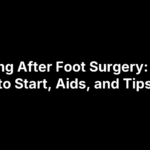The skin on your heels carries your body weight each time you stand, yet it’s often the driest patch of skin you own. When that thick layer loses moisture, it splits rather than stretches, leaving painful fissures that can snag socks, bleed, or even invite infection. Whether you spend all day on hard floors, shuffle around in flip-flops, or battle eczema or diabetes, cracked heels can turn a simple walk across the room into a wince-worthy event.
The good news: most fissures close up within a week or two once you treat them methodically. This guide walks you through the exact soak-exfoliate-moisturize cycle podiatrists rely on, shows how to seal deep splits so they stop reopening, and flags the warning signs that mean it’s time to book an appointment instead of slathering on another cream. Ready to put the bounce back in your step—and keep it there? Let’s get started.
Step 1: Pinpoint Why Your Heels Are Cracking
Fast fixes only work when you tackle the cause. Spend a minute sleuthing now and every soak, cream, and bandage you use later will pay off twice as fast.
Common everyday culprits
- Hot showers, dry winter furnaces, and going barefoot suck out skin lipids.
- Flip-flops and backless shoes let the fat pad bulge sideways, stretching the skin until it splits.
- Standing for hours on concrete—think teachers, cashiers, factory workers—adds constant shear that widens tiny surface cracks.
Underlying medical triggers
Eczema, psoriasis, athlete’s foot, and keratoderma thicken the stratum corneum; obesity and hypothyroidism reduce sweat; diabetes and peripheral neuropathy dull pain, so you don’t shift weight when fissures start. Any of these can turn a small dry patch into a deep crevasse.
Nutrient gaps that slow skin repair
Vitamin A, vitamin C, zinc, and omega-3 fats drive collagen production and keratinization. Skimp on carrots, citrus, nuts, or salmon and new skin cells arrive late and flimsy, letting cracks reopen.
Red-flag symptoms that mean “skip home care”
- Bleeding or pus-filled fissures
- Spreading redness or swelling
- Heel pain severe enough to alter your gait
- Numb or diabetic feet
If any apply, book a podiatry visit before trying home methods for how to treat cracked heels.
Step 2: Prep Your Feet—Soak, Cleanse, and Exfoliate Safely
Before any cream can do its job, the stubborn layer of dead skin has to soften. Think of this step as opening the door so moisture can actually walk in. A short soak followed by gentle exfoliation loosens the thick scales that keep fissures from closing and removes grime that could seed an infection.
Warm water foot soak: timing and add-ins
- Temperature: keep it between
100–104 °F(warm coffee, not hot tea) to avoid stripping natural oils. - Time: 10–15 minutes is the sweet spot—long enough to plump skin, short enough to prevent prune-like over-hydration.
- Boosters
- ½ cup Epsom salt for extra softening and light antimicrobial action
- A squirt of pH-balanced liquid soap to lift sweat and dirt
- A few drops of tea-tree oil if you’re prone to athlete’s foot
- Post-soak: pat—not rub—feet dry, especially between the toes where moisture can invite fungus.
Gentle exfoliation methods
- Pumice stone: Use light circular strokes for about 60–90 seconds per heel, rinsing the stone every few passes.
- Foot file or battery-powered callus remover: Glide with minimal pressure; two or three slow passes are plenty.
- Skip razor blades and metal graters—they remove living tissue, bleed easily, and widen cracks.
Rinse feet again to wash away loosened skin, then dry thoroughly.
Safety tips for sensitive or diabetic feet
- Test water with your elbow to avoid accidental burns if sensation is reduced.
- Swap abrasive tools for a soft washcloth if your skin tears easily or you’re on blood thinners.
- After drying, inspect soles under good light—or ask a family member—to catch hidden splits early.
- If you notice redness, swelling, or drainage, stop home care and call your podiatrist.
Once your heels are soft, you’re primed for the heavy hitters: moisture and occlusion. Let’s move on to the ingredients that actually rebuild the skin barrier.
Step 3: Lock In Moisture With Proven Ingredients
Soft skin won’t stay that way unless you trap water inside it. After every soak-and-scrub session, reach for formulas that draw moisture in, dissolve the stubborn callus rim, and then seal the whole package. Think of this trio—humectant + keratolytic + occlusive—as the skin-care equivalent of primer, paint, and topcoat for your heels.
Ingredient checklist you actually need
| Ingredient type | Star ingredient | Why it works | Best % range |
|---|---|---|---|
| Humectant | Urea | Hygroscopic; pulls water into deep epidermal layers | 20–40 % |
| Humectant | Glycerin | Binds water, keeps skin flexible | 5–15 % |
| Keratolytic | Lactic acid | Loosens dead keratin so cracks can close | 5–12 % |
| Keratolytic | Salicylic acid | Thins thick scales, antifungal bonus | 2–6 % |
| Occlusive | Petrolatum (Vaseline) | Forms an ≈ 100 % water-impermeable film |
— |
| Occlusive | Lanolin | Seals plus adds lipids similar to skin | — |
A single tube doesn’t need everything, but it should combine at least one humectant with an occlusive for round-the-clock barrier repair.
Nighttime occlusion routine for faster results
- After exfoliating, massage a nickel-size blob of 40 % urea cream over each heel.
- Top with a thick coat of petrolatum. Wondering if Vaseline heals cracked heels? It does—by locking in the urea so it can work eight hours straight.
- Slip on clean cotton socks or silicone heel sleeves.
- Sleep. Fissures usually look flatter and less sore after two to three nights.
Skip occlusion only if the area is weeping or infected.
Daytime moisturizing schedule
- Morning: post-shower, apply a lighter urea or ceramide cream before socks and shoes.
- Mid-shift: standing all day? Rub in a pea-size amount during lunch break—stash a travel tube in your bag.
- Evening: quick re-check; if edges look white and parched, add another thin layer.
Consistent re-application is the unsung hero of how to treat cracked heels quickly—miss a day and you reset the clock.
Step 4: Seal Deep Cracks and Protect Your Heels All Day
Even the best cream can’t knit a fissure that keeps popping open every time you take a step. Treat moisture as the mortar and this step as the scaffolding: you’re closing the gap, shielding it from pressure, and giving new skin a calm place to grow.
Liquid bandage or cyanoacrylate glue application
- Clean and dry the crack, then pinch the skin edges together.
- Run a hair-thin line of liquid bandage over the seam and hold for about 60 seconds.
- Let it air-dry; showering is fine, but avoid soaking for the first 12 hours.
- Re-apply every 2–3 days until the gap fills with pink skin.
Skip this trick if the fissure is oozing, infected, or deeper than ⅛-inch—those need a pro.
Padding and taping for pressure relief
- Cut a hydrocolloid patch or moleskin “donut” so the hole surrounds, not covers, the crack’s center.
- Place it on the heel rim; the pad off-loads weight to the healthy skin around it.
- For extra security, wrap athletic tape in a figure-eight pattern so it stays put overnight.
Footwear fixes that prevent splitting
- Trade backless sandals for sneakers or clogs with a firm heel counter; they keep the fat pad from splaying.
- Slip gel heel cups or a custom orthotic with a slight heel lift into work shoes to absorb shock.
- Rotate pairs daily; dry, cushioned insoles reduce shear and keep the seal intact.
Combined, these simple barriers let your moisturizing routine do its job—no reopening, no setbacks.
Step 5: Lifestyle Tweaks to Speed Healing and Stop Cracks Coming Back
Creams fix the symptom; daily habits fix the cycle. Small, consistent changes keep moisture in your skin and pressure off your heels, making future fissures far less likely.
Hydration, diet, and supplements
Sip 8–10 cups of water so the epidermis never runs on empty. Plate up salmon, chia seeds, and walnuts for omega-3s; snack on carrots, citrus, and a handful of pumpkin seeds to hit your vitamin A, C, and zinc targets. Stick to the RDA—megadoses won’t close cracks faster.
Build a 5-minute daily foot-care routine
- Quick warm rinse; towel-dry thoroughly.
- Inspect soles and nail edges with a hand mirror.
- Massage in urea or ceramide cream.
- Pull on moisture-wicking, cushioned socks.
- Air out shoes overnight.
Seasonal and occupational adjustments
Add a bedroom humidifier in winter and switch to thicker petrolatum blends. In summer, rinse off pool chlorine and limit flip-flops to short trips. If you stand all day, use anti-fatigue mats and schedule 2-minute stretch breaks every hour to unload heel pressure.
Step 6: When Home Fixes Aren’t Enough—Professional Treatments
If you’ve given the soak-exfoliate-moisturize routine a solid two weeks and the splits still gape, or if pain, bleeding, or diabetes is in the picture, it’s time to tag in a podiatrist. Medical care speeds closure, slashes infection risk, and tackles any hidden biomechanical or skin disease drivers behind stubborn heel fissures.
Prescription-strength topicals
Your doctor can write for heavyweight formulas you won’t find on store shelves:
- 40–50 % urea ointments that dissolve callus in days, not weeks
- Compounded salicylic-urea creams that thin and hydrate at the same time
- Topical retinoids that boost cell turnover and collagen so cracks knit tighter
Expect mild stinging the first day or two; most people notice smoother edges within a week.
In-office debridement and callus planing
Using a sterile scalpel, the podiatrist gently shaves away thick, yellow rim tissue—no needles required. Removing dead layers instantly relieves pressure so fissures can close without reopening each step you take.
Advanced therapies for chronic or infected fissures
- Biologic dressings (collagen or amniotic grafts) create a moisture-rich scaffold for rapid healing.
- Platelet-rich plasma injections jump-start tissue repair with your own growth factors.
- Custom orthotics redistribute weight to keep new skin intact.
What to expect during a podiatry visit
History, gait and vascular checks, footwear review, then a personalized treatment plan are standard. Many insurance plans cover debridement and prescriptions; call ahead about copays. Walk out with clearer instructions—and usually, much happier heels.
Quick Recap & Next Steps
Pressed for time? Here’s the 60-second refresher:
- Find the “why.” Dry indoor heat, flimsy sandals, eczema, diabetes, or a vitamin shortfall can all set the stage.
- Soak + exfoliate. Ten minutes in warm water, then a gentle pumice pass opens the gates for moisture.
- Moisturize like you mean it. Urea or lactic acid draws water in; petrolatum locks it there—twice daily is non-negotiable.
- Seal deep splits. A liquid bandage plus donut padding keeps fissures closed so they can knit.
- Fix the environment. Hydrate, wear cushioned closed-back shoes, and take micro-breaks if you stand all day.
- Escalate when needed. Two weeks with no progress, bleeding, infection signs, or diabetic feet? Call the pros.
Most readers who follow this playbook see noticeable relief within 7–14 days. If you’re in Central Virginia and your heels still feel like cracked desert ground—or you simply want expert eyes on diabetic feet—our board-certified podiatrists are ready to help. Book a same-day or telehealth visit with the Achilles Foot and Ankle Center and step back into comfort, faster.






